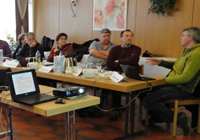Extensive grazing in Europe - how best to formulate our demands for CAP reform?
14th and 15th December, 2012, Hungen (Germany)

What is the best way to achieve our goals for the better definition, differentiation and appropriate protection of semi-natural pastures? Are there specific political buttons we could push? Are there administrative issues we should take into account? Are we better to aim for simplicity or complexity? And can semi-natural pastures be incorporated on the all-important LPIS (Land Parcel Identification System)? These were the types of issues under discussion in a non-governmental workshop organised by the Deutsche Verband für Landespflege and EFNCP in the small German town of Hungen.
The event was a chance to reflect on what had been discussed in our earlier Brussels seminar, and in particular the messages on CAP reform and permanent pastures coming from the European Commission and European Parliament. Rainer Luick asked whether there was anything left to play for; having had the background outlined by Gwyn Jones, Guy Beaufoy concluded that most of the specific issues of interest to EFNCP were still quite open, and he outlined the preferred policy framework.
National cases studies illustrated some of the technical and political complexities. Augusta Costa and Inocêncio Seita Coelho showed how something as apparently simple as a change in the relative value of products is raising big political questions in Portugal as timber-orientated pine woods (non-agricultural and ineligible for direct payments) become pinenut-producing pine woods (agricultural and therefore eligible). Two of the possible eligibility scenarios were presented as examples; depending on the choice taken, the resulting area payment might not increase or decrease by around 10%, but the geographical patterns of payment distribution would also vary.
EFNCP has always believed that getting semi-natural pastures correctly incorporated into the Integrated Administration and Control System (IACS) and LPIS (which underlies IACS) is the essential precondition of a workable policy. Some of the most useful discussions focussed on this topic, drawing heavily on the input of one of the EU's top experts in this field - Wim Devos of the MARS Unit of the European Commission's Joint Research Centre (JRC).
The JRC has analysed the crop codes used in all the Member States and regions. As well as the 10 basic codes (listed below), it was made clear that additional codes are not only possible (they make up an average of 10% of all the current codes), but often desirable to ensure clarity for claimants, administrators and auditors. Examples were shown of codes covering mosaics of forage and non-forage areas, in which the eligible area was calculated using a pro rata rule.
The 10 basic land cover classes
A arable land
G grassland
N natural grassland
H greenhouse
T permanent tree crop
S permanent scrub crop
C permanent herbaceous crop
P short rotation coppice
R (irrigated) rice
K kitchen gardens (SAPS only)
Complementing this EU-wide perspective was Juan Busqué, who explained the technical approach being taken in Cantabria, Spain, and the practical and political difficulties being faced there. The default Spanish approach to eligibility was deemed to be unsuitable, at least in the case of slope-based exclusion of communal pastures. The use of pro rata approaches in practice was illustrated and the need for ground-truthing to moderate the initial findings from remote sensing was stressed.
An example of the degree of flexibility which may be available if can be combined with clarity from an auditing perspective was provided by Norbert Roeder, who presented the approach being suggested by the German Government (see this summary).
The take-home messages included:
- Within the overall constraints set by the Regulations, all eligible pastures can and should be paid for. Currently this means that however good the implementation for herbaceous pasture, woody forages will continue to be a problem - the Regulations must be changed in this regard
- Auditors don't like 'surprises' - land cover/use categories and their descriptions must reflect reality, for example, the proportion and type of forage available. Implementing authorities must develop crop code lists which include as many classes as are necessary to reflect the diversity of their farmland - oversimplification can cause audit problems down the line
- Frequently-updated remote sensing-based mapping is both essential and cheap (suitable raw data is now available at prices as low as €15 per square kilometre)
- Remote sensing based mapping is not enough and must be complemented by on-the-ground monitoring and control



